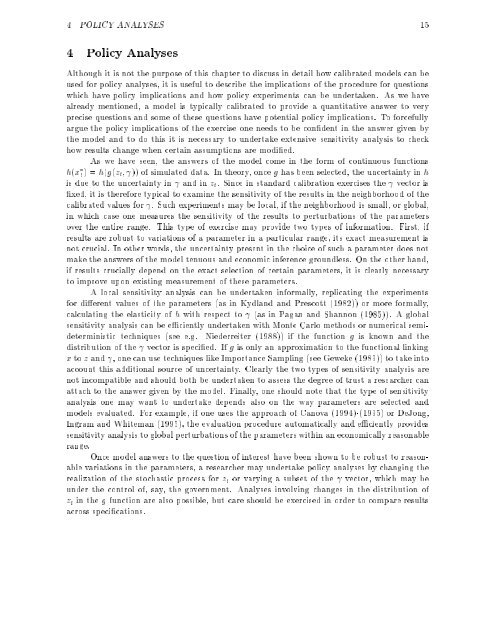Testing Calibrated General Equilibrium Models - Universitat ...
Testing Calibrated General Equilibrium Models - Universitat ...
Testing Calibrated General Equilibrium Models - Universitat ...
You also want an ePaper? Increase the reach of your titles
YUMPU automatically turns print PDFs into web optimized ePapers that Google loves.
4 POLICY ANALYSES 15<br />
4 Policy Analyses<br />
Although it is not the purpose of this chapter to discuss in detail how calibrated models can be<br />
used for policy analyses, it is useful to describe the implications of the procedure for questions<br />
which have policy implications and how policy experiments can be undertaken. As we have<br />
already mentioned, a model is typically calibrated to provide a quantitative answer to very<br />
precise questions and some of these questions have potential policy implications. To forcefully<br />
argue the policy implications of the exercise one needs to be con dent in the answer given by<br />
the model and to do this it is necessary to undertake extensive sensitivity analysis to check<br />
how results change when certain assumptions are modi ed.<br />
As we have seen, the answers of the model come in the form of continuous functions<br />
h(x t )=h(g(zt )) of simulated data. In theory, once g has been selected, the uncertainty inh<br />
is due to the uncertainty in and in zt. Since in standard calibration exercises the vector is<br />
xed, it is therefore typical to examine the sensitivity of the results in the neighborhood of the<br />
calibrated values for . Such experiments may be local, if the neighborhood is small, or global,<br />
in which case one measures the sensitivity of the results to perturbations of the parameters<br />
over the entire range. This type of exercise may provide two types of information. First, if<br />
results are robust to variations of a parameter in a particular range, its exact measurement is<br />
not crucial. In other words, the uncertainty present in the choice of such a parameter does not<br />
make the answers of the model tenuous and economic inference groundless. On the other hand,<br />
if results crucially depend on the exact selection of certain parameters, it is clearly necessary<br />
to improve upon existing measurement of these parameters.<br />
A local sensitivity analysis can be undertaken informally, replicating the experiments<br />
for di erent values of the parameters (as in Kydland and Prescott (1982)) or more formally,<br />
calculating the elasticity ofh with respect to (as in Pagan and Shannon (1985)). A global<br />
sensitivity analysis can be e ciently undertaken with Monte Carlo methods or numerical semideterministic<br />
techniques (see e.g. Niederreiter (1988)) if the function g is known and the<br />
distribution of the vector is speci ed. If g is only an approximation to the functional linking<br />
x to z and , one can use techniques like Importance Sampling (see Geweke (1989)) to takeinto<br />
account this additional source of uncertainty. Clearly the two types of sensitivity analysis are<br />
not incompatible and should both be undertaken to assess the degree of trust a researcher can<br />
attach to the answer given by the model. Finally, one should note that the type of sensitivity<br />
analysis one may want to undertake depends also on the way parameters are selected and<br />
models evaluated. For example, if one uses the approach ofCanova (1994)-(1995) or DeJong,<br />
Ingram and Whiteman (1995), the evaluation procedure automatically and e ciently provides<br />
sensitivity analysis to global perturbations of the parameters within an economically reasonable<br />
range.<br />
Once model answers to the question of interest have beenshown to be robust to reasonable<br />
variations in the parameters, a researcher may undertake policy analyses by changing the<br />
realization of the stochastic process for zt or varying a subset of the vector, which maybe<br />
under the control of, say, the government. Analyses involving changes in the distribution of<br />
zt in the g function are also possible, but care should be exercised in order to compare results<br />
across speci cations.
















